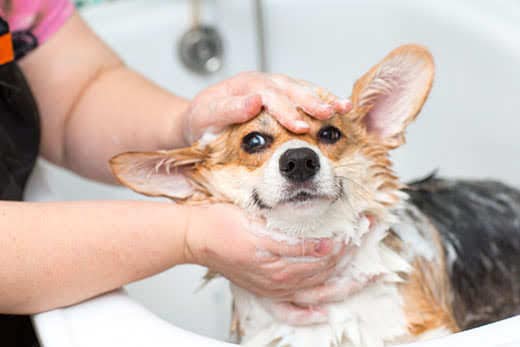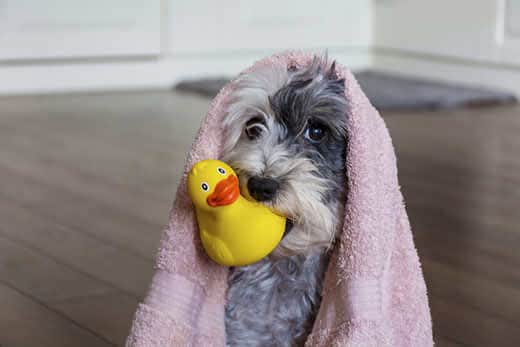
Why dogs don’t like to bathe and tips on how to wash a frightened dog
Sometimes dogs like to splash in puddles and don’t get out of the pool, but when it’s time to take a bath, they tuck their tail and hide. If it’s not the water, why do so many dogs tremble and whine when bathed? And how to wash a dog if she is afraid?
Contents
Why do dogs hate bathing?
Yes, not all pets like to play in the water, but this does not explain their dislike for the bathing process. Even water-loving breeds such as Labrador—retrievers. So, if it’s not the water, then why do dogs hate taking baths? This can be explained by a number of factors.

bad associations
According to The Dodo, just one bad bathing experience can be enough to injure a dog and cause him to become afraid of water procedures. Scalding in hot water, slipping and falling in the tub, getting water in your nose or shampoo in your eyes can all make your pet think bathing is unsafe. Even unpleasant experiences associated with other types of care, such as painful nail trimming, can cause unpleasant associations with bathing if these procedures are carried out at the same time.
Loss of control
When a four-legged friend goes swimming or splashes in a stream, he chooses this fun activity. However, washing is usually forced on the dog, and in the process it is picked up and moved from place to place against its desires. This lack of choice and feeling out of control can be very frustrating for your pet.
unfamiliar action
The dogs that wash for the first time or not very often, they may simply be frightened by the very fact of being in the bathroom or being soaped with shampoo. This, in turn, can lead to the formation of negative associations that will make them wary of bathing in the future.
Stressful situation
Sometimes the process of bathing is not only for the dog. Pets pick up the emotional signals that their owners send them. “If you treat washing your dog as a stressful situation, she will follow suit,” notes Dogster. Shouting at an animal, treating it rudely, and rushing to wrap up such a tedious task as quickly as possible will give the dog a reason to consider bathing something to be afraid of. Even if family members treat the pet with care, but wash it, when for some reason they experience negative emotions, he will feel their condition. This may be enough for him to become afraid of bathing in the future.
How often should you wash your dog
Is not it pets need to bathe regularly? It depends on the circumstances. Most often, dogs are washed simply to make it easier to live with them. No one likes to find traces of dirt all over the house and cuddle with a smelly dog.
Short-haired breeds with healthy skin don’t really need bathing. For their own good, they don’t really need regular bathing and should only be bathed if they get very dirty. In most cases, it is enough to wipe them with special wipes for pets. Breeds with wrinkled skin, such as pugs or sharpeis, should regularly wipe the skin between the folds.
On the other hand, long-haired breeds and curly-coated dogs benefit from regular shampooing and conditioning. It helps to prevent permanent matting, although daily brushing can also help. Hairless breeds, such as the Mexican Hairless Dog, need regular bathing to keep their skin from drying out. And pets with oily skin, for example cocker spanielsneed frequent baths to prevent buildup of sebum.
How to wash a dog if he is afraid of water
If your dog’s skin or coat type makes bathing necessary, the best thing to do is prepare him. So she can enjoy the process of washing, or at least not be afraid of it. This will require replacing negative associations with positive ones, as well as time and patience. The amount of effort will depend on whether the pet is terrified of bathing or simply expresses slight dissatisfaction with what is happening. Perhaps he is somewhere in the middle.
1. Keep calm
First of all, it is important to make sure that the owner himself demonstrates a positive attitude towards bathing the dog. If he is in a hurry somewhere, is stressed, or is unhappy with the pet, you should wait and bathe him in a calmer state.
2. Form positive associations

is ready, you can put the bowl directly into the tub. If your four-legged friend is large enough, you can let him climb inside on his own to reinforce his sense of choice and control.
Once your dog has learned to sit in the tub without fear, you can remove the bowl and turn on the water. It is advisable to give her toys so that she can play in the water, as well as treats.
When the pet learns to calmly tolerate the sound of running water and his wet paws, you can sprinkle a little on him, making the process fun and easy and turning it into a game. Then you need to slowly pour water on it and lather it with shampoo, while showering it with praise and soothing words. At any point in this process, if your four-legged friend starts to get agitated, stop and try again the next day.
3. Prevent the development of negative associations
Security measures must be taken. For example, put an anti-slip mat or stick anti-slip stickers on the bottom of the tub to prevent your dog from slipping. Consider using a bath harness similar to those used by professional groomers.
You should also check the temperature of the water to make sure it is neither too hot nor too cold. Do not splash or pour water directly on the dog’s face. Instead, it is better to use a special washcloth to wash the muzzle and other sensitive areas. At the same time, other care proceduressuch as trimming nails and brushing teeth should be rescheduled for another day.
The reasons why dogs dislike being washed may be different, but the solutions remain the same regardless of such reasons. With a lot of patience, affection and care, the owner will be able to change the dog’s attitude to bathing and make this process more enjoyable and less stressful for everyone.
See also:
- Why is my dog afraid of everything?
- Games with a dog who loves to swim
- How to Reward Good Behavior
- Why is my dog itching?





